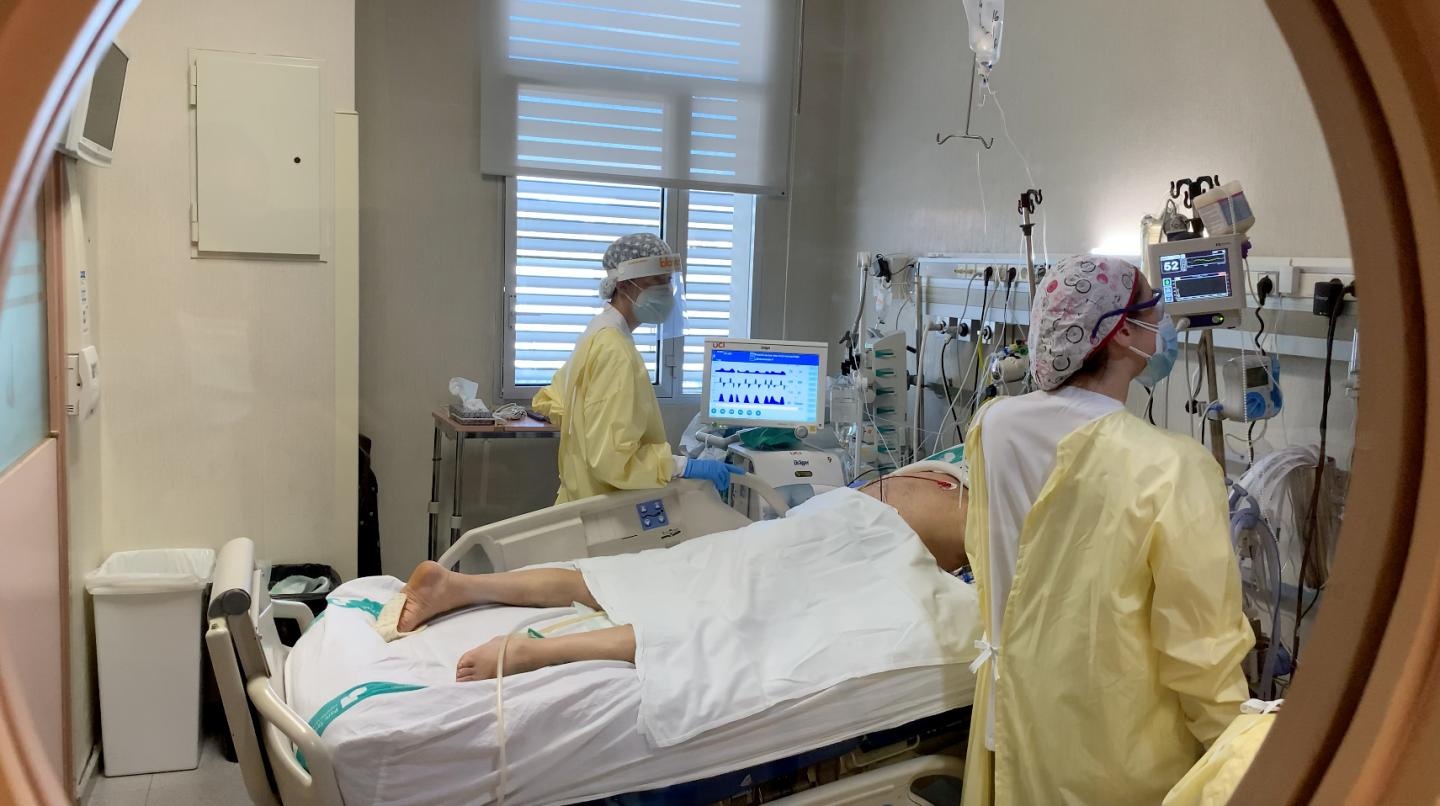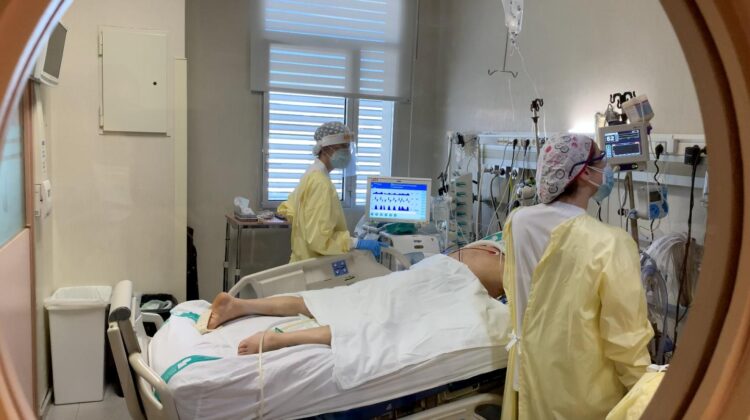Microvascular health as a key to improve patient care

Credit: ©ICFO/Commissió Europea
As COVID-19 spread worldwide in early 2020, the avalanche of patients requiring admission into intensive care units (ICUs) suddenly became overwhelming to the healthcare systems. About 10% of hospitalized COVID-19 patients entered these ICUs in the first wave, and most of them required invasive mechanical ventilation (IMV) due to respiratory failure. Of note, mortality among patients requiring this procedure was extremely high, ranging from 35 to 50%. One of the main features of the disease is the damage in the blood vessels, not only in the lungs, but also in other organs. This causes strokes, renal failure or heart injury. Such organ damage might be responsible for the evolution towards multi-organ dysfunction and, eventually, the death of the patient.
Monitoring and managing acute respiratory failure and hemodynamics, blood flow in the body, is critical in the ICU. Knowing this, and based on their consolidated experience, the team of scientists led by ICREA Prof. at ICFO Turgut Durduran believed that the technology being developed by the Medical Optics group at ICFO, in collaboration with colleagues from Politecnico di Milano and HemoPhotonics, could be adapted and implemented to potentially improve the management of COVID-19 patients in ICUs.
VASCOVID was conceptualized based on these ideas. The aim of the project is to develop a portable, non-invasive, cost-effective and real-time platform for the monitoring of the microvascular health (the health of microvessels) of COVID-19 patients in ICUs. This would, in turn, assist clinicians in personalizing the treatments of patients.
The platform combines two bio-photonics technologies based on near-infrared light. Near-infrared light is shined through the palm of a patient, travels deep (>1 cm) into the tissue, interacts with the blood in the microvessels and obtains information about blood flow and blood oxygenation of COVID-19 patients.
The platform is expected to have a high impact on the management of COVID-19 patients at the ICUs. The platform will also be of use for a broader range of patients such as those suffering from sepsis and acute respiratory distress syndrome. The underlying goal is the personalization of the patient management based on biomarkers derived from evaluating the microvascular health and the endothelial function. In addition to the prognostic value of the degree of endothelial impairment caused by the disease, the technology provides biomarkers to evaluate heart-lung interactions, helping clinicians to carry out personalized management of ventilation strategies in order to avoid ventilator-induced lung injury, or to screen readiness to wean from the mechanical ventilator, the final stage of the respiratory support, and that often fails due to cardiovascular insufficiency.
Coordinated by ICREA Prof. at ICFO Turgut Durduran, the consortium comprises seven partners from Europe: ICFO, Consorci Corporacio Sanitaria Parc Tauli de Sabadell, Politecnico di Milano (POLIMI), and the companies HemoPhotonics, BioPixs Limited, Splendo Consulting BV and Asphalion.
As ICREA Prof. at ICFO Turgut Durduran highlights, “We have been working with this technology using near infrared light for over a decade in projects related to neuro-monitoring, cancer screening and others. We were able to use our experience in these applications at hospitals worldwide to rapidly adapt to the needs of the COVID-19 management and propose this new platform. Prof. Davide Contini, from Politecnico di Milano, continues “We have the challenge of completing this project in a very short-time scale, but we are certain that we will achieve this goal. We also note that COVID-19 will be stopped with the amazing advances in vaccines but this technology will be applicable to many patient groups at the ICUs as well as for our preparedness for future pandemics of this nature”. Durduran concludes that “Future-proofing healthcare is one important lesson we have learned from the pandemic.”
Dr. Jaume Mesquida, intensivist from the C.S. Parc Taulide Sabadell, emphasizes that “This is a great opportunity in the evolution of monitoring in the ICU towards non-invasive technologies. Its features, such as being wireless and portable, make it an ideal device for these types of units. We hope to use this device on the maximum number of patients possible to actually measure its effectiveness and see if the information we obtain could be translated into a parameter that helps us to make decisions”
The vision of the VASCOVID platform
The platform is expected to have a high impact on the management of COVID-19 patients as well a broad range of others such as those suffering from sepsis and acute respiratory distress syndrome. It intends to be all inclusive and automated with all the additional components necessary to be practical and usable in ICUs. Finally, it will be an important enabler for the large-scale testing of new treatments and therapies aimed to address microvascular impairment and to reduce extubation failure on ICU patients weaning out of mechanical ventilation.
Light and Microvessels
The non-invasive approach used by VASCOVID combines two bio-photonics technologies, time-resolved near-infrared spectroscopy (TR-NIRS) and diffuse correlation spectroscopy (DCS). The device uses light to penetrate deep (>1 cm) into the tissue of the palm of the patient’s hand, reach the micro vessels and measure specific variables such as oxygenated and de-oxygenated hemoglobin concentrations and blood flow. The device also includes an automated tourniquet to induce a period of ischemia to the palm by inflating the tourniquet above the arterial blood pressure. The response of the microvasculature to such a challenge is known to be an indicator of both microvascular and endothelial health.
Now, why the palm of the hand? In critical care, peripheral tissues have been used as a window for evaluating global organ perfusion status. This approach relies on the fact that peripheral non-vital areas are the first ones to be sacrificed in situations of cardiovascular insufficiency. On that behalf, previous clinical studies have proven that the microvessels of a patients’ palm give an overall view of what is happening in our bodies. Namely, if the micro-vessels in the palm are not functioning right, this means that our body in general is not working right and probably major danger awaits ahead.
###
LINKS
- VASCOVID website: http://vascovid.
eu/ - Link to Media KIT: https:/
/ bit. ly/ 3pib23T - Link to the Video of the European Commission (English-Catalan) https:/
/ www. youtube. com/ watch?v= dvXUxOWslfA
Media Contact
Alina Hirschmann
[email protected]





